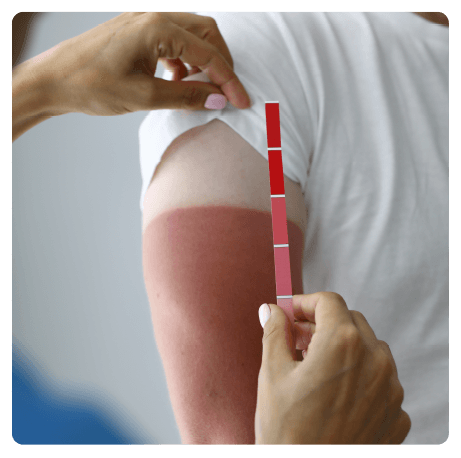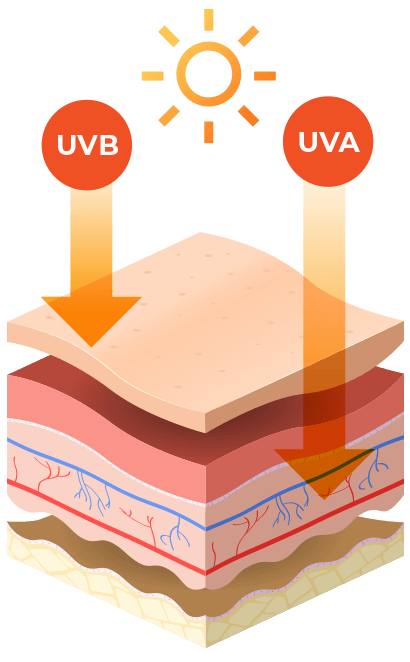Sunburn
Sunburn is acute inflammation of the skin that follows excessive exposure to UV radiation3b. UV radiation damages DNA in skin cells, resulting in redness of the skin and death of skin cells3c. Sunburn can occur within 15 minutes4, and the damage that is caused is permanent, irreversible and adds up with each exposure to the sun5a.
Sunburn
Sunburn is acute inflammation of the skin that follows excessive exposure to UV radiation3b. UV radiation damages DNA in skin cells, resulting in redness of the skin and death of skin cells3c. Sunburn can occur within 15 minutes4, and the damage that is caused is permanent, irreversible and adds up with each exposure to the sun5a.
Factors that influence sunburn include3d:
- Wavelength: UVB rays are the principal cause of sunburn
- Skin type/pigmentation: people with darker skin require 3-5 times more
UV exposure than those with lighter skin to cause sunburn - Hydration: moist skin burns more easily than dry skin
- Reflection: UV rays are reflected off surfaces, snow, ice and sand
– sunburn can occur in the shade6a! - Ozone: decrease in ozone layer means less UV rays are filtered out
- Altitude and latitude: UV exposure is greater at higher altitudes and closer to the equator
- Time of day: UV exposure is greater from 10 am to 4 pm
- Season: UV exposure is greater during summer than in winter
- Cloud cover: clouds absorb only about 10 % of UV radiation
– sunburn can occur when it is overcast6b!

There are two types of UV rays that damage our skin6c:
- UVB rays are responsible for tanning and sunburn that can ultimately lead to skin cancer
- UVA rays damage skin cells causing ageing. UVA rays are also the cause of another form of skin cancer

How quickly do you burn in the sun?
The Fitzpatrick chart classifies skin into six different types, depending on your tendency to tan, burn or both. Type I skin is light and always burns, while Type VI is the darkest skin type that never burns3e. It is important to note that although people with darker skin have more protection against sun damage, everyone is at risk of the harsh African sun, therefore sun protection is paramount regardless of skin pigment5b.
Skin Tone7
Type 1
Pale White skin
Extremely sensitive skin, always burns, never tans
Example: Red hair with freckles
Skin Tone7
Type 2
White skin
Very sensitive skin, burns easily, tans minimally
Example: Fair-skinned, fair-haired Caucasians, Northern Asians
Skin Tone7
Type 3
Light Brown skin
Sensitive skin, sometimes burns, slowly tans to light brown
Example: Darker Caucasians, some Asians
Skin Tone7
Type 4
Moderate Brown skin
Mildly sensitive skin, burns minimally, always tans to moderate brown
Example: Mediterranean and Middle Eastern Caucasians, Southern Asians
Skin Tone7
Type 5
Dark Brown skin
Resistant skin, rarely burns, tans well
Example: Some Hispanics, some Africans
Skin Tone7
Type 6
Deeply pigmented dark brown to black skin
Very resistant skin, never burns, deeply pigmented
Example: Darker Africans , Indigenous Australians

Burning on cloudy days
- It is possible to get sun burnt on cool, hazy or cloudy days6b.
- Sand, water and other surfaces can reflect UV rays6a, reflections can lead to an increase in exposure.
